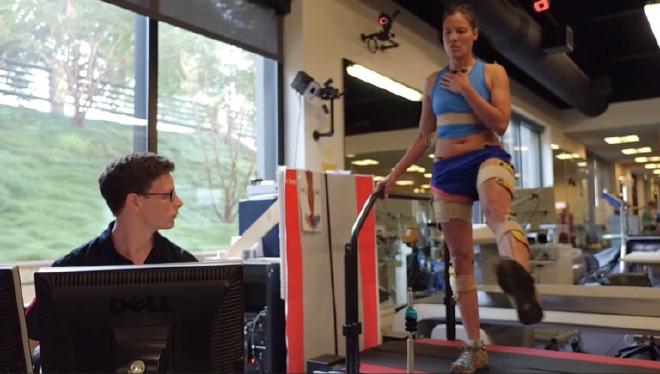

Researchers from the University of Utah, New York University and Stanford University are now demonstrating the potential for another option: gait retraining.
Published in The Lancet Rheumatology and co-led by Scott Uhlrich of Utah’s John and Marcia Price College of Engineering, these findings come from the first placebo-controlled study to demonstrate the effectiveness of a biomechanical intervention for osteoarthritis.
“We’ve known that for people with osteoarthritis, higher loads in their knee accelerate progression, and that changing the foot angle can reduce knee load,” said Uhlrich, an assistant professor of mechanical engineering. “So the idea of a biomechanical intervention is not new, but there have not been randomized, placebo-controlled studies to show that they’re effective.”
A personalized approach to gait retraining #
With support from the National Institutes of Health and other U.S. federal agencies, the researchers were specifically looking at patients with mild-to-moderate osteoarthritis in the medial compartment of the knee—on the inside of the leg—which tends to bear more weight than the lateral, outside, compartment. This form of osteoarthritis is the most common, but the ideal foot angle for reducing load in the medial side of the knee differs from person to person, depending on their natural gait and how it changes when they adopt the new walking pattern.

“Previous trials prescribed the same intervention to all individuals, resulting in some individuals not reducing, or even increasing, their joint loading,” Uhlrich said. “We used a personalized approach to selecting each individual’s new walking pattern, which improved how much individuals could offload their knee and likely contributed to the positive effect on pain and cartilage that we saw.”
This personalized analysis also screened out potential participants who could not benefit from the intervention in instances where none of the foot-angle changes could decrease loading in their knees. These participants were included in previous studies, which may have contributed to those studies’ inconclusive pain results.
Yes, as always there are promising results, but more clinical trials are needed to refine the process #
Moreover, after their initial intake sessions, half of the 68 participants were assigned to a sham treatment group to control for the placebo effect. These participants were prescribed foot angles that were actually identical to their natural gait. Conversely, participants in the intervention group were prescribed the change in foot angle that maximally reduced their knee loading.
Participants from both groups returned to the lab for six weekly training sessions, where they received biofeedback—vibrations from a device worn on the shin—that helped them maintain the prescribed foot angle while walking on the lab’s treadmill. After the six-week training period, participants were encouraged to practice their new gait for at least 20 minutes a day, to the point where it became natural. Periodic check-in visits showed that participants were adhering to their prescribed foot angle within a degree on average.
A year later #
After a year, all participants self-reported their experience of knee pain and had a second MRI to quantitatively assess the damage to their knee cartilage.
“The reported decrease in pain over the placebo group was somewhere between what you’d expect from an over-the-counter medication, like ibuprofen, and a narcotic, like oxycontin,” Uhlrich said. “With the MRIs, we also saw slower degradation of a marker of cartilage health in the intervention group, which was quite exciting.”
Beyond the quantitative measures of effectiveness, participants in the study expressed enthusiasm for both the approach and the results. One participant said, “I don’t have to take a drug or wear a device…it’s just a part of my body now that will be with me for the rest of my days, so that I’m thrilled with.”
“Especially for people in their 30s, 40s or 50s, osteoarthritis could mean decades of pain management before they’re recommended for a joint replacement,” Uhrlich said. “This intervention could help fill that large treatment gap.”
“We and others have developed technology that could be used to both personalize and deliver this intervention in a clinical setting using mobile sensors, like smartphone video and a ‘smart shoe,’” Uhlrich said. Future studies of this approach are needed before the intervention can be made widely available to the public.
Citation #
The study, titled “Personalised gait retraining for medial compartment knee osteoarthritis: a randomised controlled trial,” was published on Aug. 13 in The Lancet Rheumatology. Co-lead authors are Valentina Mazzoli of NYU’s Department of Radiology and Julie Kolesar of Stanford’s Human Performance Lab. Co-authors include Amy Silder, Andrea Finlay, Feliks Kogan, Garry Gold,** Scott Delp** and Gary Beaupre of Stanford and the VA Palo Alto Medical Center. The research was supported by federal research grants from the U.S. Department of Veterans Affairs, National Institutes of Health and National Science Foundation.
- The article A potential way to relieve arthritic knees without drugs or surgery, signed by Evan Lerner, John and Marcia Price College of Engineering was published in the University of Utah’s website
Contact [Notaspampeanas](mailto: notaspampeanas@gmail.com)

